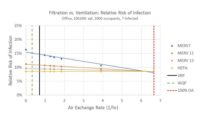If there’s ever been a time to prioritize IAQ, it’s now. With students and faculty back in the classroom, it’s critical that school buildings nationwide invest in the kind of indoor air quality sensors that will help them meet and exceed the recommendations outlined by the CDC.
Here are a few most meaningful measures to consider when testing indoor air quality.
Abide by the CDC’s Recommended Indoor Air Quality Standards
HVAC sensors in a school play a small but important role in the building’s IAQ. While they can’t replace other measures like social distancing, antibacterial cleaning, and the wearing of masks, the CDC does recommend that schools take the following steps to ensure that its air filtration systems are doing their part.
- Increase outdoor air ventilation;
- Disable demand-controlled ventilation (DCV);
- Further open minimum outdoor air dampers — as high as 100%, if possible — to eliminate recirculation;
- Keep systems running longer hours — 24/7, if possible — to enhance the actions above;
- Consider portable room air cleaners with HEPA filters; and
- Consider ultraviolet germicidal irradiation (UVGI) to protect occupants from radiation, particularly in high-risk spaces.
Track the “Big Four” Air Quality Threats with Sensors
With so many students and faculty sharing the same spaces, it falls on your HVAC and air filtration systems to maintain optimal IAQ. But, if you don’t have a way to monitor those systems, your efforts to improve air quality may be stunted.
Dr. Junfen Zhang, professor of global and environmental health at Duke University's Nicholas School of the Environment, told Business Insider that he recommends “diligently monitoring and working to improve the IAQ in our homes [and facilities] through regular testing and making adjustments to our daily habits.”
The technology to provide these insights is highly accessible, too, in the form of indoor air quality sensors that track the following IAQ threats to your school facility.
CO2
Too much CO2 in your building may lead to headaches, excessive drowsiness, and a general lack of concentration in faculty and students alike. When you install CO2 sensors in the space, you can ensure that CO2 levels are monitored and managed continuously, so they never exceed a healthy ppm.
Volatile Organic Compounds (VOC)
Air quality sensors for VOCs will measure air contaminants from other sources besides respiration (CO2). These include building materials, cleaners, perfumes, cigarette smoke, cooking odors, body odor, bathroom odors, paint, furniture, and carpet off-gassing.
Temperature
Keeping students and faculty alert and healthy means maintaining a comfortable temperature across each classroom and in every season of the year. Investing in an air quality sensor with high accuracy, reliability, and multiple form factors will enable you to maintain a comfortable (and cost-effective) temperature.
Humidity
Mold spores can be found just about anywhere, and when they’re given the right moisture levels, they can grow and start causing serious health problems, especially in children and adults who have compromised immune systems.
Good humidity sensors will achieve within 1%-2% accuracy and give you clear insights into your school’s humidity levels. If there’s an excess of moisture in the air, your sensors should be automated to inform you or help your HVAC system address it before occupants notice the humidity.
It’s More Important than Ever to Improve IAQ
Improving IAQ in any facility, especially a school, means investing in technologies, such as building automation systems (BASs), IAQ sensors, and filtration or ventilation devices. The insights from sensors can provide the necessary data to tell you whether your building is achieving your targeted IAQ standards.
If your school’s air conditioning units aren’t functioning as intended, it’s critical that sensors have the functionality to tell you why the units are malfunctioning, what effect that malfunction is having on the quality of air, and how you can program your HVAC systems to address the issue and continue to ensure the healthiest indoor air quality.




